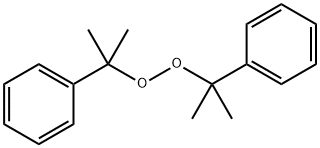
Дикумил пероксид
- английское имяDicumyl peroxide
- CAS №80-43-3
- CBNumberCB8211170
- ФормулаC18H22O2
- мольный вес270.37
- EINECS201-279-3
- номер MDLMFCD00675945
- файл Mol80-43-3.mol
| Температура плавления | 39-41 °C (lit.) |
| Температура кипения | 130°C |
| плотность | 1.56 g/mL at 25 °C (lit.) |
| плотность пара | 9.3 (vs air) |
| давление пара | 15.4 mm Hg ( 38 °C) |
| показатель преломления | 1.5360 |
| Fp | >230 °F |
| температура хранения | 2-8°C |
| растворимость | Chloroform (Slightly), DMSO (Slightly), Methanol (Slightly) |
| форма | flakes |
| цвет | White |
| Растворимость в воде | insoluble |
| Гидролитическая чувствительность | 4: no reaction with water under neutral conditions |
| БРН | 2056090 |
| Стабильность | Reacts violently with reducing agents, heavy metals, concentrated acids, concentrated bases. May ignite organic materials on contact. May decompose violently upon exposure to sunlight or if heated. Incompatible with strong oxidizing agents. |
| LogP | 5.6 at 25℃ |
| Справочник по базе данных CAS | 80-43-3(CAS DataBase Reference) |
| Непрямые добавки, используемые в веществах, контактирующих с пищевыми продуктами | DICUMYL PEROXIDE |
| FDA 21 CFR | 175.105; 177.2600 |
| FDA UNII | M51X2J0U9D |
| Система регистрации веществ EPA | Dicumyl peroxide (80-43-3) |
| UNSPSC Code | 12162002 |
| NACRES | NA.23 |
| Коды опасности | O,Xi,N,Xn | |||||||||
| Заявления о рисках | 7-36/38-51/53-36/37/38-20 | |||||||||
| Заявления о безопасности | 14-3/7-36/37/39-61-14A-45-26-36-17 | |||||||||
| РИДАДР | UN 3110 5.2 | |||||||||
| WGK Германия | 2 | |||||||||
| RTECS | SD8150000 | |||||||||
| F | 4.2 | |||||||||
| TSCA | Yes | |||||||||
| Класс опасности | 5.2 | |||||||||
| Группа упаковки | II | |||||||||
| кода HS | 29096000 | |||||||||
| Банк данных об опасных веществах | 80-43-3(Hazardous Substances Data) | |||||||||
| Токсичность | LD50 orally in Rabbit: 4100 mg/kg | |||||||||
| NFPA 704: |
|
рисовальное письмо(GHS)
-
рисовальное письмо(GHS)




-
сигнальный язык
опасность
-
вредная бумага
H315:При попадании на кожу вызывает раздражение.
H319:При попадании в глаза вызывает выраженное раздражение.
H360D:Может отрицательно повлиять на неродившегося ребенка.
H411:Токсично для водных организмов с долгосрочными последствиями.
H242:При нагревании возможно возгорание.
-
оператор предупредительных мер
P210:Беречь от тепла, горячих поверхностей, искр, открытого огня и других источников воспламенения. Не курить.
P235:Держать в прохладном месте.
P273:Избегать попадания в окружающую среду.
P280:Использовать перчатки/ средства защиты глаз/ лица.
P308+P313:ПРИ подозрении на возможность воздействия обратиться за медицинской помощью.
P370+P378:При пожаре тушить сухим песком, сухим химическим порошком или спиртостойкой пеной.
Дикумил пероксид химические свойства, назначение, производство
Химические свойства
Dicumyl peroxide is a crystalline solid that melts at 42°C. It is insoluble in water and soluble in vegetable oil and organic solvents . It is used as a high-temperature catalyst in production of polystyrene plastics. The deflagration hazard potential of this peroxide was tested using 5 g of igniter in the revised time–pressure test, but no pressure rise was produced . Noller et al. found it to be an intermediate fire hazard.Использование
Dicumyl peroxide(DCP) is used:in vulcanization of rubber
as a crosslinking agent in the synthesis of polylactic acid composite fibers
in the preparation of polyethylene composites
in the synthesis of polyamide 112/ethylene vinyl acetate copolymer blends.
Общее описание
Dicumyl peroxide is a pale yellow to white granular solid with a characteristic odor. It is used as a polymerization catalyst and vulcanizing agent.Профиль реактивности
The explosive instability of the lower dialkyl peroxides (e.g., dimethyl peroxide) and 1,1-bis-peroxides decreases rapidly with increasing chain length and degree of branching, the di-tert-alkyl derivatives being amongst the most stable class of peroxides. Though many 1,1-bis-peroxides have been reported, few have been purified because of the higher explosion hazards compared with the monofunctional peroxides. Dicumyl peroxide is unlikely that this derivative would be particularly unstable compared to other peroxides in it's class, Bretherick 2nd ed., p 44 1979.Профиль безопасности
Mildly toxic by ingestion. See also PEROXIDES. When heated to decomposition it emits acrid smoke and irritating fumes.Методы очистки
Crystallise the peroxide from 95% EtOH (charcoal). Store it at 0o. Potentially EXPLOSIVE. [Beilstein 6 IV 3220.]